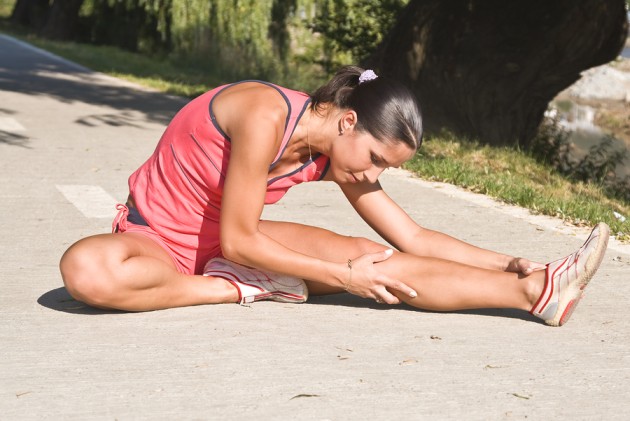
Static stretching
Stretching and Muscle Soreness
Some research suggests that stretching doesn’t prevent muscle soreness after exercise. Researchers Robert Herbert, Ph.D., and Marcos de Noronha, Ph.D. of the University of Sydney conducted a systematic review and meta-analysis of 10 previously published studies of stretching either before or after athletic activity. They concluded that stretching before exercise doesn’t prevent post-exercise muscle soreness. They also found little support for the theory that stretching immediately before exercise can prevent either overuse or acute sports injuries.
Stretching and Performance
Research physiologists at Nebraska Wesleyan University made the headlines in 2009 when they published study results indicating that more flexible runners had lower running economy (how efficiently they use oxygen) than runners with tight hamstrings. Consequently, those runners were faster than the ‘flexible’ runners. Yes, it was a very small study, and yes, they only measured sit and reach scores. But the results were still a bit surprising and brought more attention to the question: To should or not to stretch ?
Warm up vs. Stretching
Much of this confusion comes from a misinterpretation of research on warm up. These studies found that warming by itself has no effect on range of motion, but that when the warm up is followed by stretching there is an increase in range of motion. Many people misinterpreted this finding to mean that stretching before exercise prevents injuries, even though the clinical research suggests otherwise. A better interpretation is that warm up prevents injury, whereas stretching has no effect on injury.
If injury prevention is the primary objective the evidence suggests that athletes should limit the stretching before exercise and increase the warm up time.
Studies do support that range of motion can be increased by a single fifteen to thirty second stretch for each muscle group per day. However, some people require a longer duration or more repetitions. Research also supports the idea that the optimal duration and frequency for stretching may vary by muscle group.
The long-term effects of stretching on range of motion show that after six weeks, those who stretch for 30 seconds per muscle each day increased their range of motion much more than those who stretched 15 seconds per muscle each day. No additional increase was seen in the group that stretched for 60 seconds. Another 6 week study conducted found that one hamstring stretch of 30 seconds each day produced the same results as three stretches of 30 seconds.
These studies support the use of thirty second stretches as part of general conditioning to improve range of motion.
Is Flexibility Overrated?
When sorting out all the research on stretching and flexibility for athletes, it’s important to remember that the goal of stretching is to develop and maintain an appropriate range of motion around specific joints. It’s also important to realize that stretching (or releasing) tight muscles should go hand in hand with strengthening the weak muscles.
I’m sure we’ll continue to see headlines for and against stretching, but if you choose to stretch, it may be best to customize your routine to fit your needs. Assess your body and your sport and make sure you stretch (and strengthen) in order to reduce muscle imbalances.
How To Stretch
After exercise, cool down and hold a given stretch only until you feel a slight pulling in the muscle, but no pain. As you hold the stretch the muscle will relax. As you feel less tension you can increase the stretch again until you feel the same slight pull. Hold this position until you feel no further increase.
If you do not seem to gain any range of motion using the above technique, you may consider holding the stretch longer (up to 60 seconds).
What Stretch is Best?
In general, Proprioceptive Neuromuscular Facilitation (PNF) stretching has resulted in greater increases in range of motion compared with static or ballistic stretching, though some results have not been statistically significant.
Static stretches are a bit easier to do and appear to have good results. Studies indicate that continuous stretching without rest may be better than cyclic stretching (applying a stretch, relaxing, and reapplying the stretch), however some research shows no difference.
Most experts believe ballistic, or bouncing during a stretch, is dangerous because the muscle may reflexively contract if restretched quickly following a short relaxation period. Such eccentric contractions are believed to increase the risk of injury.
In addition to improving range of motion, stretching is extremely relaxing and most athletes use stretching exercises to maintain a balance in body mechanics. But one of the biggest benefits of stretching may be something the research can’t quantify: it just feels good.
Read more articles about Stretching.
Check out our Physiotheraphy section, every Monday a new story! Tomorrow read about Sprained ankle treatment.